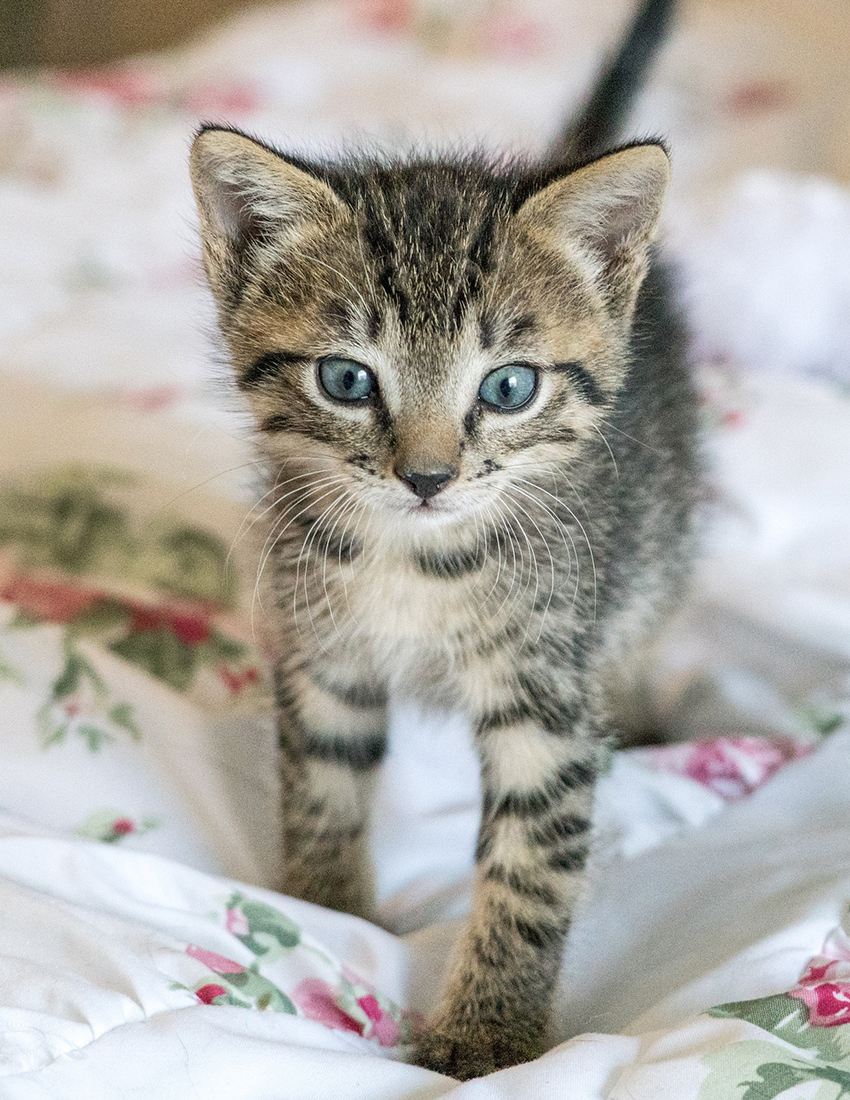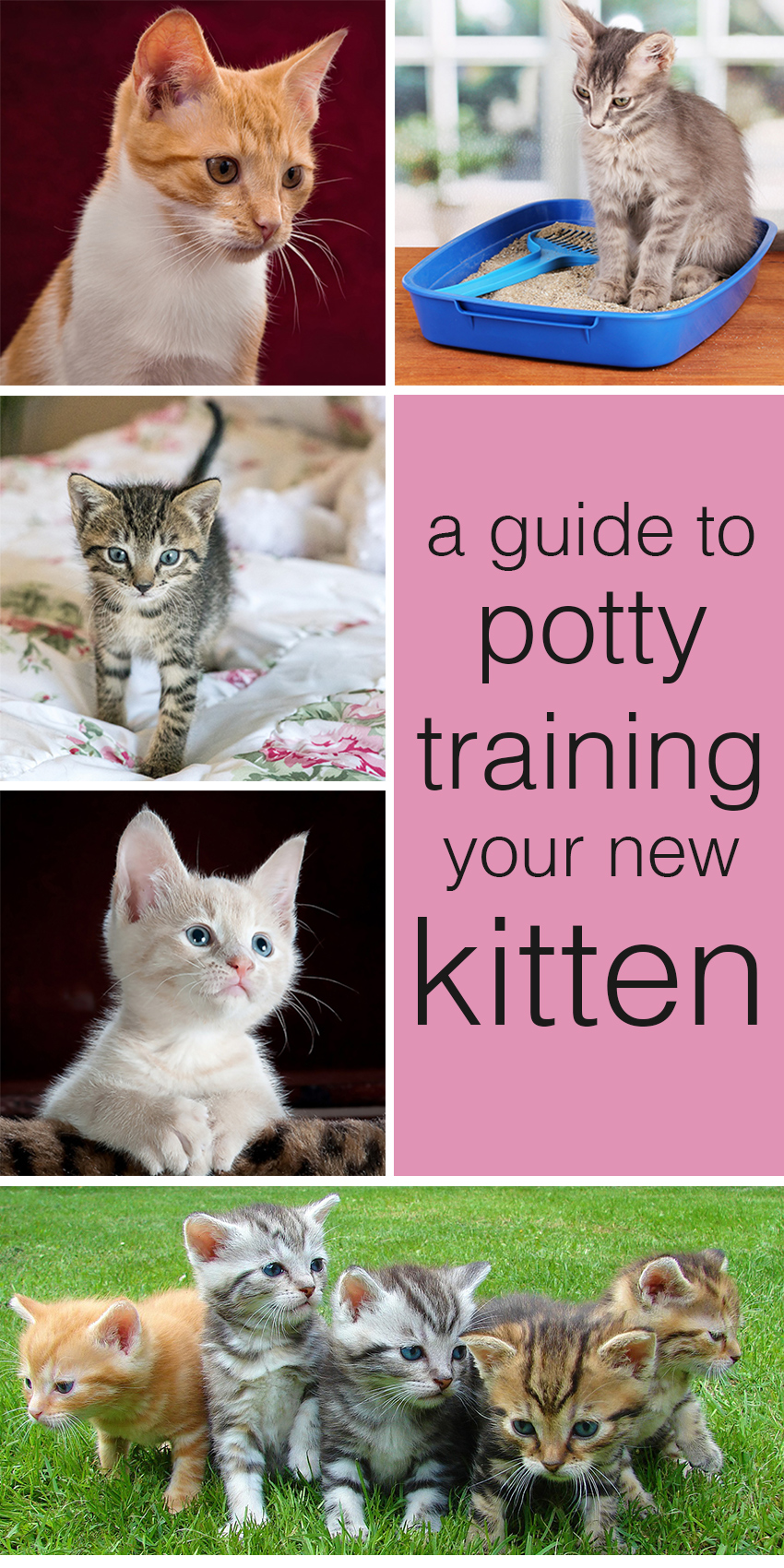
Cat toilet training seems easy. You put a litter box in the corner of the room, fill it with kitty litter, and they use it to do their business. But there are mistakes that lots of new cat owners make, which can lead to a kitten finding somewhere else to go. And not everyone wants to train a kitten to poop in a litter box, you might want your future outdoor cat to pee in the backyard.
Contents
- Potty training your kitten
- Litter box locations
- Why won’t my kitten use her litter box?
- Choosing the right equipment
- Teaching your kitten to poop outdoors
Most kittens bred indoors will learn to use a litter box when they are still with their mother. They will copy her peeing and pooping into a litter tray from as early as 4 weeks of age. So she should be kind of litter trained before she even arrives at your home.
You might get lucky, bring your kitten home and have her using her litter box straight away. But she might be overwhelmed in a much bigger room, or with a box with a different smell, and be unwilling to use it. To have the best chance getting it right from the start, set your cat up to win. And remember, accidents encourage further accidents.
How To Potty Train A Kitten
There are a few things that you can do to ease the transition for both of you. Provide her with the right litter box, in the right location, with the right amount of litter. Location is key. Make it easy to find and use it.
Don’t give your kitten the run of the house straight away. To begin with, confine her to a single room. This will help her to be less overwhelmed by her new surroundings. It will also make it easier for her to find and use the tray.
Ensure that the room is clean and clear of any debris. Temporarily put pot plants elsewhere. If possible push furniture into the corners of the rooms that do not contain litter boxes. This will reduce the temptation to use the wrong location.
Where To Put The Litter Box?
The best location for a cat litter box is somewhere away from food preparation, but within your kittens easy access. Make sure your kitten knows where the litter box is located, and that he doesn’t have anything blocking his way. Don’t close any doors between him and the box. Make sure he can see it from wherever you are going to spend most of your time with him.
It is also advisable to put a litter box in the corner of the room, as animals naturally use corners to go to the bathroom. If you find that the litter box is in one corner and the kitten uses another, then simply move the cat toilet to that location or put an alternative there. Help the cat litter box training along by giving them clear signals like this about what the desired behavior is.
You might want your cats litter box to go in the bathroom as this feels the cleanest to you. However, if your bathroom door is always closed or is a long distance from where your kitten usually hangs out, then you will make it far harder for him to learn to use it. Remember, your litter box can be moved slowly over the period of a few days.

My Kitten Won’t Use Her Litter Box!
It’s not unusual for new owners to find their kitten reluctant to pee in the litter box. Please don’t punish mistakes. It won’t teach them anything, other than to be wary of you, and not to go to the toilet when you are watching. Making it even harder for you to help them learn in the future.
Instead move your cat temporarily to a single room in the house, where it is possible to close the door. Put a litter tray in each corner. Your kitten should start using one of the trays in this scenario fairly soon.
After a day they will hopefully have a preference for just one, and you can remove the others. After a couple of days open the door and allow access to one single further room or the hallway. Increase the area they can access by one room per day, reducing again if there are any accidents.
Make sure that the confined areas have constant access to water and lots of toys to keep them entertained during the few days you are focusing on litter training.
Which Litter Box Is Best?
There are a lot of choices when it comes to kitty litter boxes. Various styles and colours. Different ways of accessing the box, including those with lids or open sides. Even self cleaning litter boxes! The key points to consider when picking the best litter box are:
- Can my kitten easily get in
- Can I easily keep it clean
- Will the litter stay inside
The most important thing is that your kitten can easily get in and out of the little box. Some adult cat sized boxes have very steep sides. These can be tricky for a kitten to climb. They easy access to prevent them from simply going to the toilet elsewhere.
When you have chosen a functional tray for your cat toilet training, you need to consider hygiene and possibly appearance. But function must come before fancy! If you decide to get a litter box with a lid, leave it off for the first few days. This will help your kitten see that the tray is full of kitty litter to dig about in.
Litter boxes for cats which have flap style doors are entirely enclosed. These appeal to you as an owner because they trap stray litter, smells and unpleasant sites inside, but they are not ideal for tiny kittens. They don’t want to have to go to the effort of navigating a door every time they need to empty their bowels or bladder.

Cat Litter For Kittens
If you haven’t used a litter box before, you might be surprised to find how many different cat litter choices there are. We have tried various types when our cat was cat toilet training, and found very varying results between brands. Our personal favorite is the clumping variety. It allows you to easily spot and remove any pee as well as poop.
If you have a long haired kitten or cat breed you will need to be careful which brand of litter you choose. Some clumping varieties can get stuck and matted in their fur. You can buy odor control litter, but you shouldn’t really leave their waste in the box for so long that it causes a stink.
The cheapest option will probably not be ideal for some cat owners, but is worth a try if you have a short haired cat who is good at keeping himself clean.
How Much Litter Should I Use?
Some cat litter boxes will come with a recommended fill line. If not you need to put in enough litter so that your cat can dig down and cover up his waste. But not so much that it flies straight out of the box as soon as he starts to move it around. This will usually be around an inch deep, but will depend upon the type of box you have bought.
You might find that you have some spill or some uncovered poops the first couple of times your cat uses his litter box, but don’t worry. Just adjust the quantity over the first few days, until your cat can cover his poops, but doesn’t leave litter flying everywhere.
Is Kitty Litter Dangerous?
The cat litter itself should not be dangerous to him or to you. It’s the poop that can on rare occasions cause problems. The first risk comes if you are a pregnant woman, or one who is currently trying to conceive.
There is a parasite that cat poop often carries, which causes an infection called toxoplasmosis. Whilst fairly harmless in general, toxoplasmosis can damage a developing foetus. It is therefore sensible if you are trying to conceive or pregnant, not to clean out your cat’s litter box. Although the risks of catching it aren’t enormous, if you do catch it the consequences to your baby could be very serious.
Germs!
The other risk of cat litter is simply one of hygiene. Cat poop carries a lot of germs, and if you leave it too long it will potentially start making your family unwell. You can reduce this risk significantly by having a structured cleaning regime for dealing with your cat’s waste. Put poop or urine soaked litter into a disposable diaper sack, before carrying it straight to the outdoor trash can.
How Often Should I Clean Out My Cat’s Litter Box?
Your cat’s litter tray should be cleaned thoroughly once a day with a pet safe detergent. This will stop residues of faeces and urine from sticking to the litter box. You should after scoop out any poops or pees you spot immediately after your cat has done them. If you are out of the house for a few hours, check the tray when you return and remove them then.
How To Teach A Cat To Pee Outdoors
Teaching a litter trained cat to go to the bathroom outside shouldn’t take too long, but it’s best to wait until your cat is neutered and fully vaccinated at around six months old.
The best time to train your cat to pee outdoors is when the weather is dry, as it will be much easier if the back door is kept open.
- Take your litter tray and move it closer to the back door by a few feet.
- Over the course of the next few days move it so that it is beside the door, then so that it is just outside the door.
- If your cat keeps using the tray then you can move it to the flowerbed or further into the back yard.
- Remove it after a week or so.
They should then keep using the same spot or find somewhere else in the garden to go to the bathroom.
How To Potty Train A Kitten
To potty train a kitten you will need a litter box they can access easily, a small area for them to focus on and some good quality kitty litter. If you gradually increase their living space, they should keep using the tray and stay clean in the rest of the house.
Most kittens are easy to litter train as long as you make sure that you have the right equipment, and the right sort of space for them when they first settle in.
I was shocked when my rescue cat showed no inclination to toilet outside and it took a while to get her used to outside rather than inside. I agree that removing access completely to where they used to toilet works – unfortunately the first time I did this she still went inside the house and opted for another room! I was able to restrict her access to just the kitchen and she quickly learned then to use the big outdoors (she opted for the closest garden and at this early stage keeps returning to the same spot). I guess in time she will extend her range a bit. Your advice to thoroughly clean up any trace of her old smells around old toileting places was the answer I was looking for regarding when it would be safe to let her have access to the restof the house again. I shall get a blacklight and find any traces I have missed, including where she has sprayed. Thanks for this article I found it very useful.
I have found that requesting a baggie of dirty litter from the breeder to take home with your kitten is the best way to potty train them. Just pour it over the fresh litter when you bring your kitten home. It reduces their stress to their new environment as well. They are comforted by the scents they are already familiar with. This method has always worked when I have brought home a new kitten. It even works when their is already another cat in the home just give the new kitty their own box (next to the regular box already in use by your other cat(s) ) for a few days with some litter from their old home that mama and littermates have used and integrate it (a little each day) to the litter box that you want both of your cats to use (I use a large under-bed plastic storage box as a litterbox as the cat already owned is very large and I only want to deal with cleaning one litterbox a day). This method has worked perfectly.